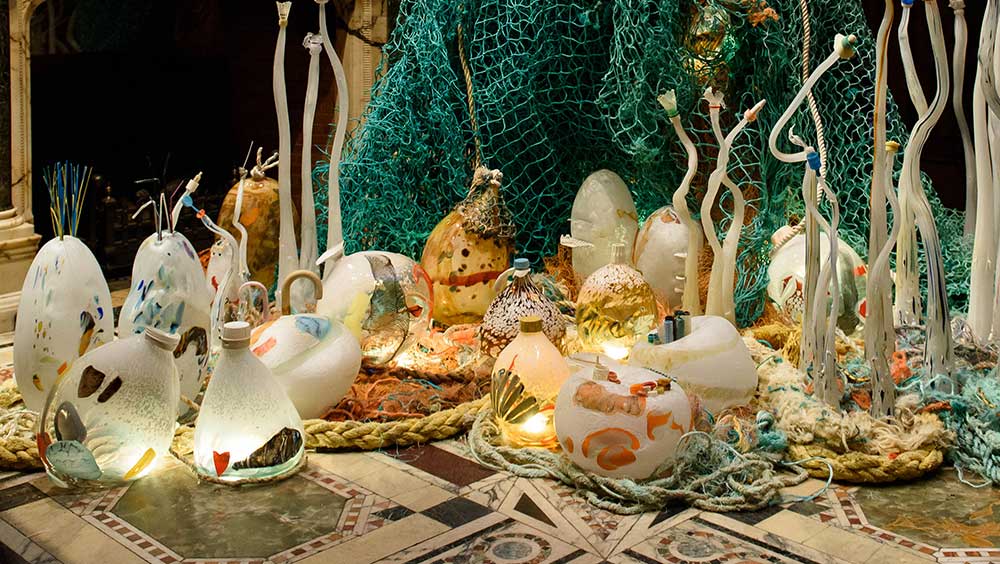
The Glass Heart: Art, Industry & Collaboration, installation view. © Two Temple Place. Photo: Richard Eaton.
Two Temple Place, London
27 January – 21 April 2024
by ANGERIA RIGAMONTI di CUTÒ
Fabric, ceramic, stone, paint, metal, alabaster: glass, it appears, can assume the guise of almost any material. It can seem diaphanous, tubular, sturdy, squishy, delicate, coarsely textured, milky and, more obviously, shimmeringly crystalline. In function, it can veer from the most basic practicality – what could be plainer than a tumbler of water – to wondrous, and sometimes absurd, spectacle; videthe sheer Victorian weirdness of Follet Osler’s 27-foot-tall glass fountain, showing off in that brazen monument to Britain’s industrial and imperial might, the Crystal Palace (1851).
The Glass Heart, in part because of its theatrical environment, feels more like a Wunderkammer than a methodically didactic survey, which is certainly not to say it isn’t illuminating. Spanning a period of 170 years, and produced in collaboration with national collections in Sunderland, Ely and Stourbridge, the exhibition, curated by Antonia Harrison, presents examples of the medium that play up its unexpected malleability and the virtuosity and experimentalism of its makers, more often viewed as craftsmen rather than artists. One of the ideas that emerges here is the intensely collaborative nature of glassmaking, reinstating the more convincing model of the Renaissance workshop in place of the contrived isolation of the quasi-divine artist that has been Romanticism’s tenacious legacy.
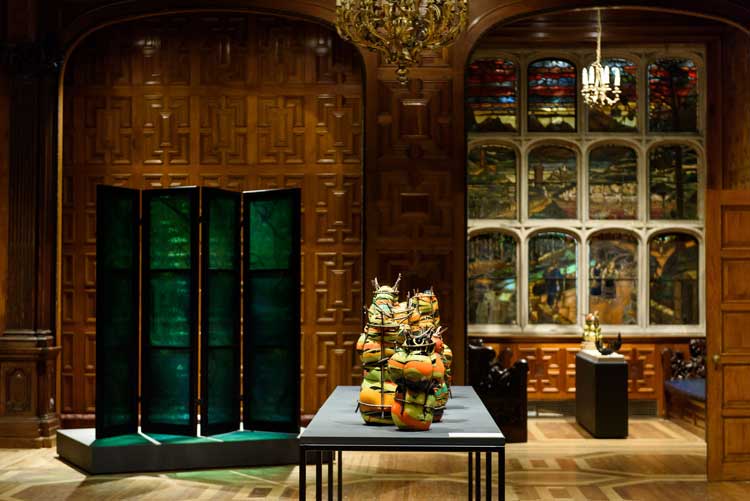
The Glass Heart: Art, Industry & Collaboration, installation view. © Two Temple Place. Photo: Richard Eaton.
The sheer technical ingenuity on display is also remarkable. In her novel The Glass-Blowers (1963), reconstructing the lives of her French glassmaking émigré ancestors, Daphne du Maurier emphasised the high quality of English technique and the humbled surprise that this elicited in the French: “Robert soon discovered that he had nothing to learn from his associates. Equally, he could not boast of any superiority in technique […] There was no question of a Frenchman crossing the Channel to teach his trade to English craftsmen; the contrary was the more likely, and Robert was quick enough to tone down any little hint of patronage.”
An integral part of the exhibition’s overall effect is the building itself and it is scarcely possible to untangle its all-encompassing plenitude from the displayed works: to say it is the antithesis of a white cube would be an understatement. The house was commissioned in 1892 by the American financier William Waldorf Astor, the (almost) richest man in the world, an eccentric sort who went to the melodramatic lengths of faking his own death to disappear from public view as a result of family feuds, though he was soon found out and ridiculed in the press.
While not quite on the grand scale of New York’s Gilded Age Fifth Avenue mansions, this was nonetheless a no-expense-spared architectural extravaganza, the exterior fashioned in an early Elizabethan idiom, built entirely of Portland stone, with a dash of humour and technological one-upmanship in the form of a carved puttoat the entrance holding a telephone.
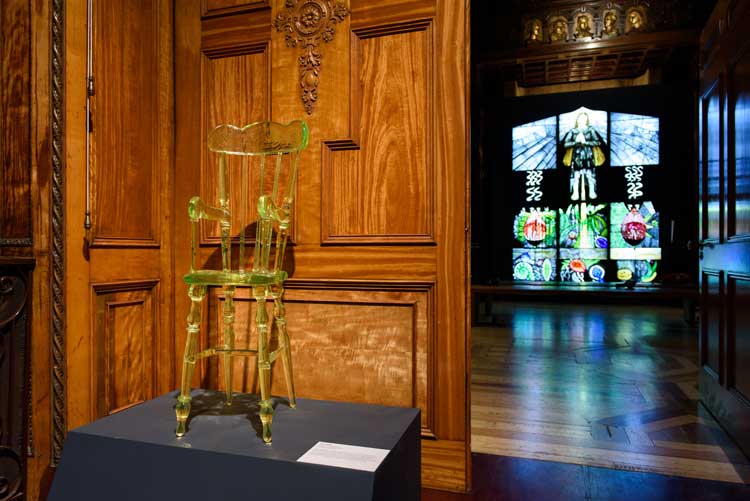
The Glass Heart: Art, Industry & Collaboration, installation view. © Two Temple Place. Photo: Richard Eaton.
Inside, the design is a loose interpretation of French Renaissance style, a horror vacui proliferation of polychromous marble, jasper, porphyry and onyx floors, stained glass, silver gilt relief panels and carved wood sculptures showcasing Astor’s mostly boyish literary predilections, among which are The Last of the Mohicans, Rip Van Winkle, The Scarlet Letter, The Three Musketeers, Othello, Macbeth and the Arthurian legend.
Glass is already an integral part of this eclectic confection, in the form of a multipanelled stained-glass ceiling covering the central atrium and grand staircase, as well as two pictorial windows bookending the great hall (the critic John Ruskin witheringly remarked that turning “painted windows into pretty pictures is one of the most gross and ridiculous barbarisms”).
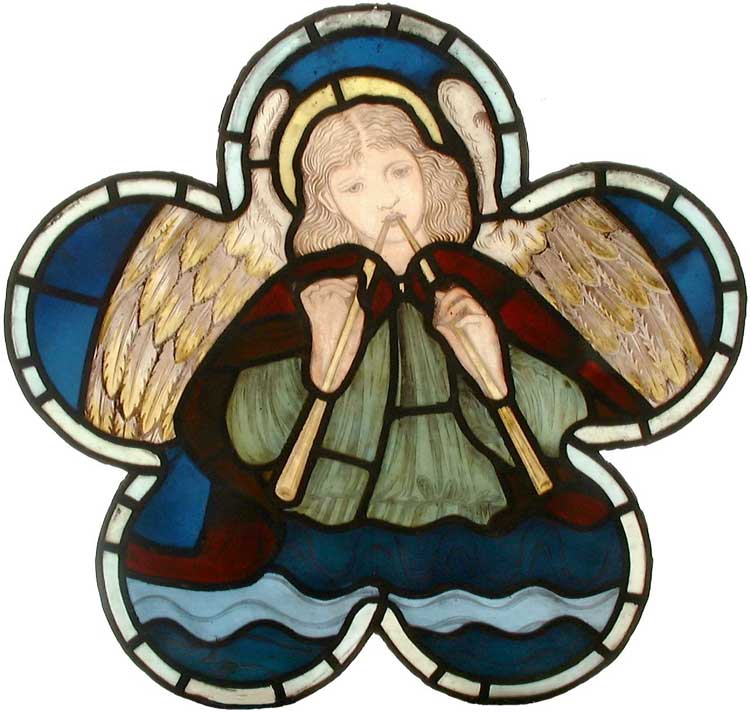
Burne Jones / Morris, Marshall, Faulkner & Co, Musician Angel (playing aulos), 1865. Stained glass panel. Courtesy of The Stained
Glass Museum.
It is within the orbit of Ruskin and his circle that the exhibition opens, with works by William Morris, Christopher and Veronica Whall, Edward Burne-Jones and Ford Madox Brown placed side by side like paintings in a gallery, an arrangement inspired by a lithograph portraying a similar display at the Great Exhibition of 1852. It is striking that the crafts experienced a fertile and resistantly nostalgic swansong in the form of the Arts and Crafts movement, just when their ability to supply basic product needs had been endangered by the Industrial Revolution.
Dating from about a century later, John Piper’s Abstract Panel (1956), executed by Patrick Reyntiens, is an elegant illustration of glass’s ability to function as a form of painting, all the more compelling here for being abstract, in contrast with the precise, medieval figuration of the Pre-Raphaelites.
Founded soon afterwards, in the 1960s, the international studio glass movement developed the material’s scope for imaginative, painterly, sculptural and even conceptual expression. One of the founders of the British flowering of the movement was Peter Layton, whose Battery – Matters of the Heart (2004) is a standout work. A cage-like metal cabinet, divided into nine compartments, contains luminously pulsating glass hearts crammed into each segment, each one in varying states of decay, from vigorous health to near deathliness (the piece was originally made for an exhibition supporting a medical charity).
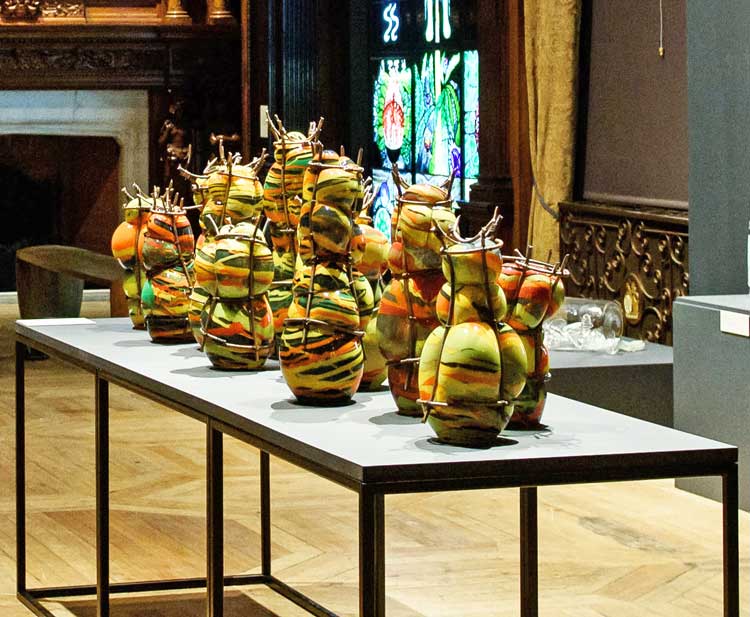
Chris Day, Judge and Jury, 2023. Glass and microbore copper pipe. Installation view, Two Temple Place, London. © Two Temple Place. Photo: Richard Eaton.
Several contemporary pieces in the exhibition exemplify the enduring reach of the studio glass movement, in work that is more overtly art than craft, often with a conceptual and socio-historic bent, though the technical skills continue to impress. Take Chris Day’s bulging, vividly striated Judge and Jury (2023), an exploration of his grappling with the judgments of being mixed race in Britain. Or Anthony Amoako-Attah’s Take Me Home (2022), a travelling bag faced in glass while somehow still resembling fabric, specifically the Kente patterns of Ghanaian textiles; similar looking carriers were used to transport belongings of Ghanaians fleeing to Nigeria.
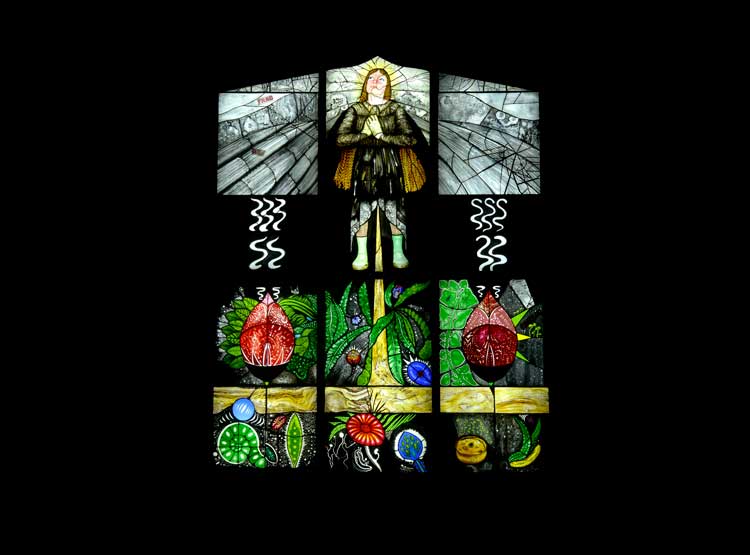
Pinkie Maclure, The Soil, 2023. © The Artist.
Also arresting are the wraithlike beauty and resourceful ingenuity of Anne Vibeke Mou’s glass cornucopias, Wild Things Inwards (2022), reworked from vintage lead crystal tableware and engraved with wild plants growing on the site of lead mines. Another work addressing sustainability in subject matter and form is Pinkie Maclure’s large stained glass, The Soil (2023), made of recycled glass and portraying a beatific gardener lavishly peeing on the earth to replenish the depleted soil.
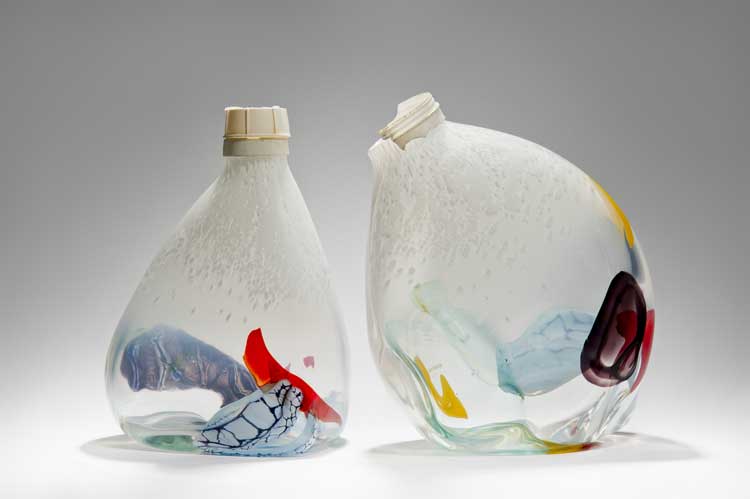
Louis Thompson and Sophie Thomas, Broken Ocean, 2022. Glass and ocean debris. © The
Artists. Courtesy of Vessel Gallery. Photo: Ester Segarra.
Far bleaker is Louis Thompson and Sophie Thomas’s portrayal of marine pollution, Broken Ocean (2019), a large-scale installation comprising a mass of entangled ghost nets emmeshed with glass vessels whose lustrous beauty is disfigured by hideous plastic screw tops.
While such creations address the planet’s degradation, it cannot be ignored that glass itself, for all its radiant allure and prodigious flexibility, is far from ecologically innocuous; counterintuitively, its production may be as environmentally damaging as plastic, taking into consideration its full lifecycle.
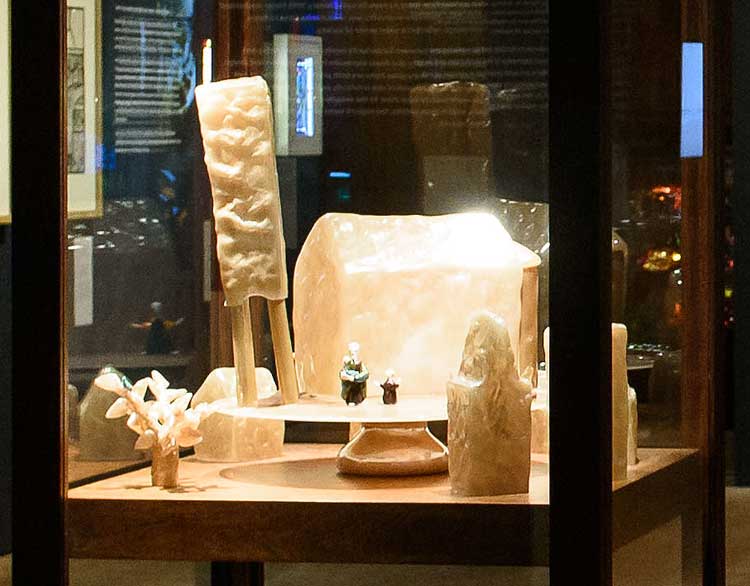
Monster Chetwynd, St Bede Enters the Monastery, 2022. Executed by glass specialists James Maskrey and Ayako Tani. Installation view. © Two Temple Place. Photo: Richard Eaton.
Reaffirming the Wunderkammer quality of the exhibition is one of my unexpectedly favourite pieces, Monster Chetwynd’s St Bede Enters the Monastery (2022). Executed by glass specialists James Maskrey and Ayako Tani, using various unconventional techniques and approximations of non-vitreous materials, this is an enchantingly cartoonish, pearlescent diorama depicting Bede’s arrival as a seven-year-old to be educated by the abbot Benedict Biscop. In some ways it feels as if glass’s indelible association with Christianity comes full circle with this work, for all the formal differences with the gothic tradition and its various aftermaths. Overall, The Glass Heart is a contemporary cabinet of curiosities that leaves an impression of wonder.